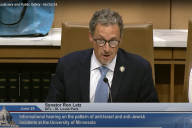You have /5 articles left.
Sign up for a free account or log in.
Higher education is at an inflection point when strategic changes are not only possible but necessary. Exciting ideas are in the air. These ideas need to be considered and, in many cases, embraced.
Here are four.
1. Create an online/low-residency option.
Online education isn’t for everyone. Many crave the campus experience: sports, parties and informal socializing. But not everyone wants this, can do this or can afford this. The time has come to create a truly immersive online or low-residency option that goes far beyond the models advanced by the current online providers.
This might be a way for institutions to dramatically increase access and inclusion -- if they prove willing to create a genuine attractive alternative to the face-to-face experience and treat this as fully equivalent to the on-campus experience.
The University of North Carolina’s proposed Carolina Away initiative provides a broad outline what such a program might look like. It entails placing the online students in cohorts and creating genuine learning communities that offer high levels of mentoring and support, along with many small group experiences and a curriculum better designed for online students than today’s course-centric model.
Instead of building the educational experience around individual, disconnected, stand-alone classes, campuses might consider a more integrated, holistic experience with a thematic or career-aligned focus.
In developing this option, institutions need to focus not just the academic, but the nonacademic, experience. Especially in an online environment, educating the whole student is more important than ever. These online programs need to devote special energies to helping online students build social connections; develop critical job-related skills, soft skills and life skills; and provide the sense of connection and the supports that are taken for granted in an on-campus environment.
2. Integrate select private institutions into the public higher education system.
Let’s not allow small colleges and the small towns that they support to die. Let’s not leave their faculty unemployed or let their facilities decay. And let’s not forget: small private institutions graduate a higher proportion of their students more rapidly than do their public counterparts, thanks to smaller classes, more mentoring and a laser focus on teaching.
Integration of private colleges into public systems is not without precedent. Many private urban institutions formed the foundation of many urban public universities. More recently, there was talk of making Sweet Briar and Hampshire into components of state universities.
All public institutions need not be alike. Giving more students an affordable liberal arts college option strikes me as genuinely exciting. Let’s not leave these indispensable institutions adrift.
3. Seize opportunities for sharing and new-model partnerships.
Higher ed is a system in name only. One of the defining characteristics of the American model of higher education -- like the American system of religion -- is competition, with institutions having distinct missions and constituencies and strengths, and each competing for students, resources and prestige. At the same time, faculty often resemble independent contractors or artisans.
Higher education might use the crisis as an opportunity to experiment with new models of course and content sharing and expanded collaboration with cultural institutions, including museums and archives. To take an example, the Gilder Lehrman Institute of American History has partnered with Pace University to deliver a master’s program for teachers that features prize-winning historians and instituted regular online conversations with leading scholars and writers for teachers nationwide.
One promising possibility is to encourage sharing and remixing of course content. Let edX disaggregate course content and allow remixing and seize this moment to live up to its original vision.
4. Trimming the costs of higher education.
Cutting costs too often means furloughs, benefit cuts, program elimination and staffing cuts. But two other possibilities loom. One is the three-year degree achieved not through trimming requirements but by encouraging students to acquire course credits elsewhere cheaper. One possibility: four-year institutions integrating with high schools and community colleges to create a true K-14 or K-16 system. Already in Idaho, more than half of high school seniors are enrolled in college, in early college and dual degree programs, as well as in workforce development and apprenticeship programs.
Another possibility is an embrace of the co-op model pioneered by Drexel, Northeastern and the University of Cincinnati. Under this model, students alternate between academics and paid work experiences.
Recent history should have taught us several lessons. One is to expect the unexpected. Much as almost no one expected the Sept. 11 terrorist attacks or the Great Recession or the outcomes of the 2016 election, the current pandemic caught us off guard. But being surprised shouldn’t paralyze us.
Another lesson involves the law of unintended consequences: We can’t foresee an event’s long-term consequences. The 1918 flu epidemic was largely forgotten. I, for one, doubt that our current health crisis will be so easily disremembered. But predictions are almost always wrong -- unless we seize the moment and try to create the future we hope for.
Yet another lesson: tragedy happens. Progress is not continuous or guaranteed. Setbacks, reverses and misfortune are part of life. It’s how we respond to those challenges that matters.
But perhaps the most important lesson is that change is life’s only constant. Much as definitions of family and marriage underwent profound transformations during our lifetime, so, too, our definition of college will evolve. We need to move toward a system that is more flexible, affordable and resilient, and that serves many more students and brings many more to goal.
To the best of our ability, we need to take command of history and make that happen.
Steven Mintz is professor of history at the University of Texas at Austin.







